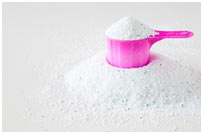Introduction
Bleaching powder is a light yellowish powder existing with a strong smell of chlorine. It is soluble in water but because of the visibility of impurities, we never observe a clear solution. Its chemical formula is Ca(OCl)Cl with its chemical name as Calcium hypochlorite.
Manufacturing of Bleaching Powder
Bleaching powder can be made by the action of chlorine on completely dry slaked lime making use of any among the following methods:
- Hasenclever’s method (old method)
- Beckmann’s method (modern method)
The reaction in both instances will be:
Ca OH2 + Cl2à Ca (OCl) Cl + H2O
Hasenclever’s Method
The device utilized in this approach contains 4 to 8 iron cylindrical tubes placed one over the other. They are interconnected and supplied with stirrers. The slaked lime is added in with a hopper in the upper cylindrical tube and is transferred from one cylinder to the other with rotating stirrers.

Chlorine added into the lowest cylinder rises up and reacts with slaked lime to form bleaching powder, which is accumulated via the electrical outlet in the lowest cylinder.
Beckmann’s Method
In this technique, a cast-iron tower with eight horizontal shelves is used. In each rack, there is a turning rake. Powdered slaked lime is introduced via a hopper at the top with compressed air.
A mixture of hot air and chlorine is added from the base of the tower. The slaked lime is pushed down by the turning rakes while chlorine rises. Reactions between slaked lime and chlorine generate bleaching powder which is accumulated at the bottom of the tower.

The apparatus uses the countercurrent principle. Thus, the optimal reaction of slaked lime and chlorine is produced with little loss of chorine. Bleaching powder needs to always be packed in air-tight containers to prevent the loss of chlorine.
Bleaching powder is a yellow-colored white powder with a strong smell of chlorine. Several of its chemical properties are listed below.
- With dilute acid, it offers hypochlorous acid.
2 CaOCl2 + dil. H2SO4àCaSO4 + CaCl2 + 2 HCl O
- It oxidizes HCl, HBr as well as HI providing the equivalent halogens.
CaOCl2 + 2 HClà CaCl2 + H2O + Cl2
- Calcium hypochlorite reacts with CO2 to create calcium carbonate and release chlorine.
CaOCl2 + CO2à CaCO3 + Cl2
- It oxidizes ammonia to nitrogen.
3 CaOCl2 + 2 NH3à 3 CaCl2+ 3 H2O + N2
Uses of Beaching powder:
Bleaching powder is utilized:
- for the laboratory preparation of chlorine and oxygen. It is likewise utilized in the manufacture of chloroform.
- as a disinfectant and in the treatment of water.
- for making unshrinkable wool.
- for bleaching cotton, linen, and also paper pulp.
- Note: Delicate textiles like wool, silk, and so on cannot be bleached with it as these could be damaged by chlorine.

